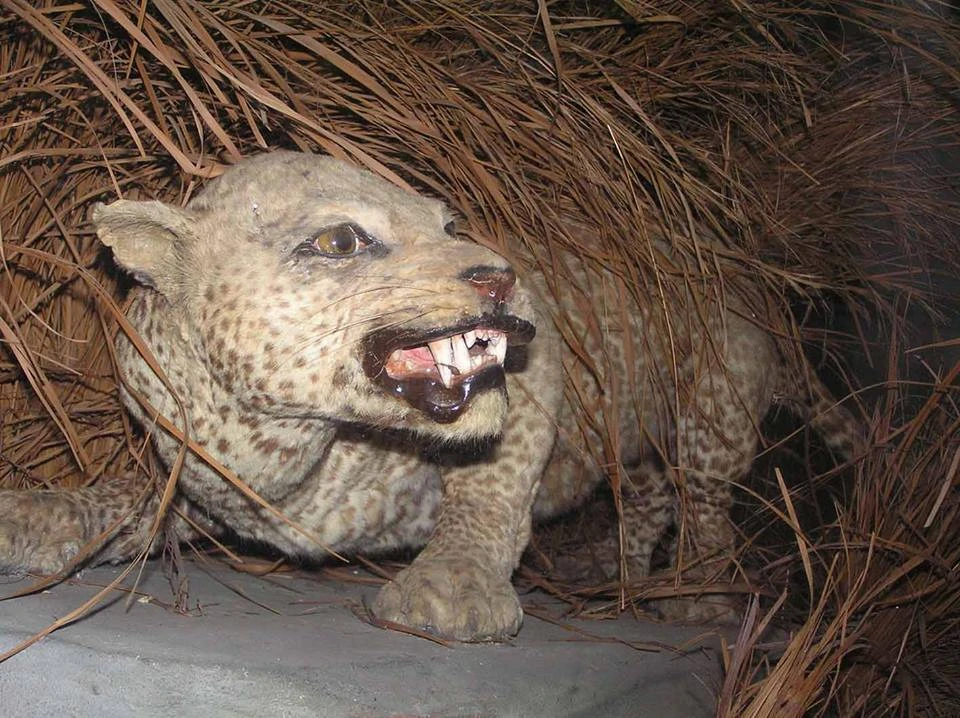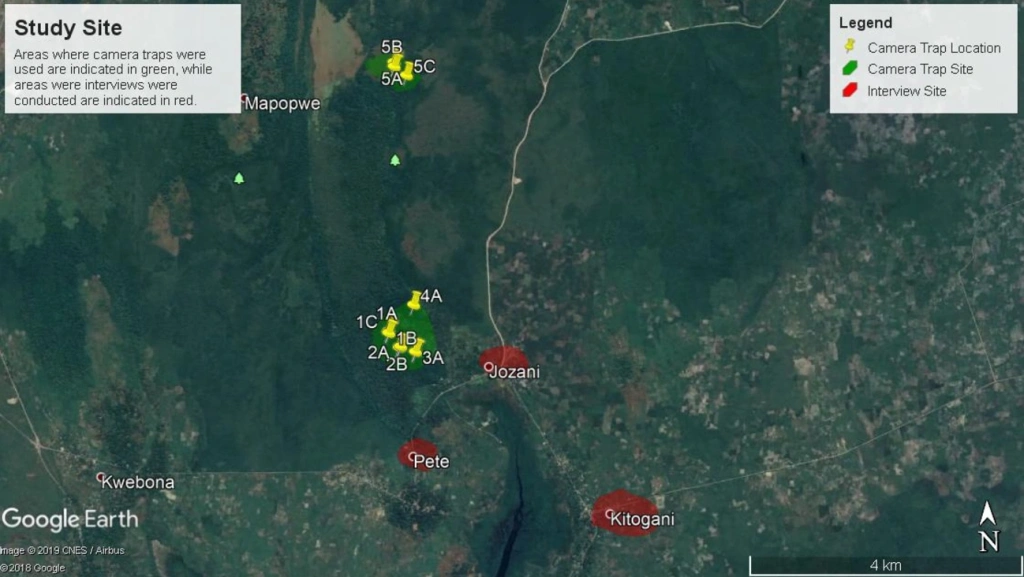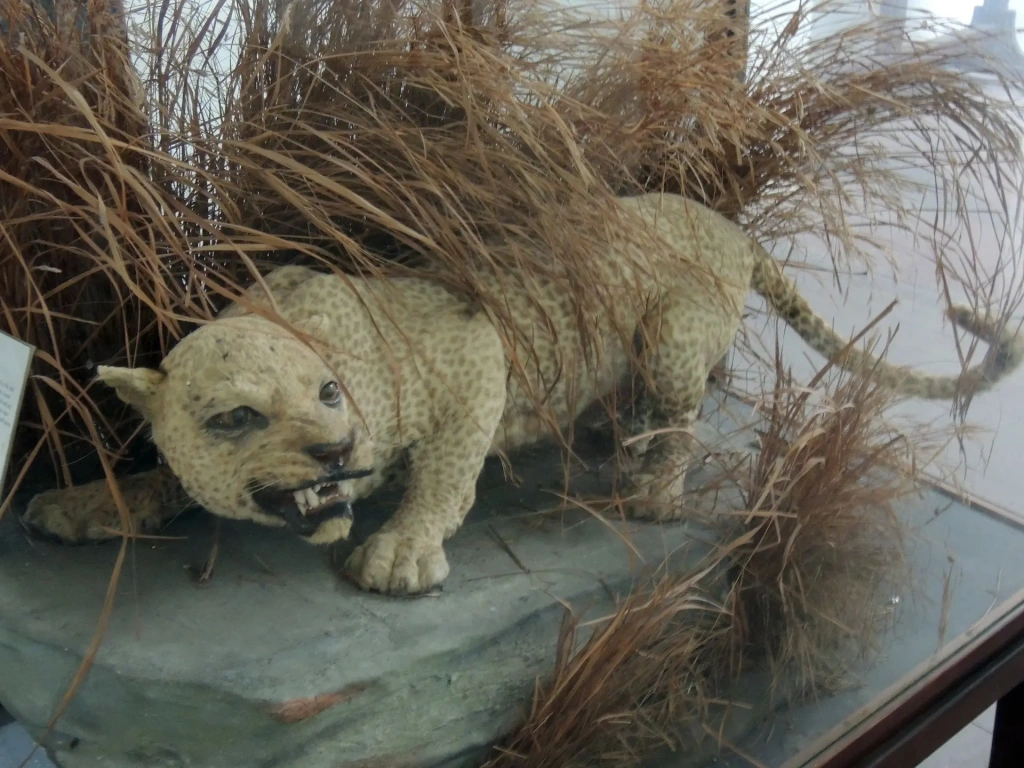Are you intrigued by the fate of the Zanzibar leopards? We've explored various sources on this mystical animal, including scientific papers and field reports from researchers. In this blog post, we will present a summary of everything known about the Zanzibar leopard to this today.
From this article, you will learn:
- Is the Zanzibar leopard a real animal or a mythological creature?
- Are there leopards on Zanzibar today?
- How does the Zanzibar leopard differ from its African counterpart?
- What’s the estimated number of Zanzibar leopards remaining in the wild?
- Who first described and who recently "rediscovered" the Zanzibar leopard?
- Has Forrest Galante found an extinct animal on Zanzibar?
- Is the Zanzibar leopard considered a separate species or a subspecies?
Was the Zanzibar leopard captured on camera?
Spotting a live Zanzibar leopard in the modern times seemed impossible. The inhabitants of , protecting their livestock and believing leopards to be a bad omen, had since eradicated all local specimens.
Then, in 2018, , a renowned American biologist, adventurer, and TV star, arrived on the island with a film crew. They were filming for his show "Extinct or Alive", set for release on Animal Planet. As implied by the title, the team scoured the globe to find extinct animals.
Did Forrest Galante find a Zanzibar leopard?
Camera traps were installed in the forest of the Jambiani-Chwaka Bay National Park. After two weeks, Galante and his team were reviewing the footage. Initially, it showed nothing significant. They nearly decided to delete the footage of other animals deemed unnecessary. Their quest to find rare animals on the island seemed frankly impossible. Suddenly, Galante saw an animal emerging from the night darkness on the screen and disappearing behind a tree seconds later. This was an incredibly emotional moment.

The intense emotions are understandable since the Zanzibar leopard was at the bottom of the show's list of expected discoveries. There was almost no hope of finding it. The last sightings of these wild cats that were reliably documented took place in 1995. When the last Zanzibar leopard was killed, that led to the cessation of their conservation programs. In light of that, when the "Extinct or Alive" wildlife biologist caught a similar animal on camera, it attracted much international attention.
Was the Zanzibar leopard camera trap footage verified?
Was it indeed a Zanzibar leopard that the show's camera crew captured on a hidden camera? The animal that was briefly spotted walking on the trail camera footage does resemble a large wild cat. Its appearance and movements closely matched those of an African leopard, albeit with some distinct features. Its body size was smaller, and its coat pattern slightly differed, with smaller barely visible black spots. The animal moved closer to the ground than other leopard subspecies. Some scientists remained skeptical of this footage. However, the possibility of the leopard's appearance in the island's forest was undisputed.
Animals typically leave evidence of their presence. Those include paw prints on the ground, claw marks on trees, droppings, and other biological signs, such as uneaten prey remains. However, despite the sensation caused in 2018, neither scientists nor local park rangers have found (or at least presented) any such evidence in the years following. The show "Extinct or Alive" successfully launched. The episode dedicated to the Zanzibar leopard attracted significant attention and viewership.
Those interested in further discussion related to the ethics of such shows may seek opinions from “debunkers”. Brendan Holmes's detailed analysis of extinct animal species is recommended for those looking deeper into the subject.
And now we will continue discussing the leopards that ended up on the small island after Zanzibar separated from the African continent .
What is known about the Zanzibar leopards?
The leopard (Panthera pardus) is a large spotted cat found in Africa and Asia. Less than ten subspecies are known. The most common of them is the African leopard (Panthera pardus pardus). This subspecies is further divided into populations depending on their geographical range. Each of those populations living in different habitats has genetic and behavioral differences. The Zanzibar leopard was (is) one such isolated population.
The Zanzibar leopard (Panthera pardus adersi) is endemic to Zanzibar, meaning the island is its only habitat. According to the commonly held view, this led to the extinction of the entire population. There was virtually nowhere on the island for them to hide.
How are Zanzibar leopards related to witchcraft?
Why did Zanzibaris kill leopards? Across Tanzania, including Zanzibar, belief in witchcraft persists. This is especially true among the older generation. People believed the Zanzibar leopard worked alongside witch doctors, and feared them greatly. The belief was that witches captured leopards, trained them to harm people, and deployed these dangerous predators against those they disliked. Additionally, there was the fear of leopards raiding villages for livestock. All this created a complex relationship between humans and leopards on the African island.
Among the beliefs of Zanzibar's indigenous people, leopards have a special, "evil" status. It's thought that some individuals can tame these animals by feeding them food containing magical ingredients. Once the elusive predator is subdued by its owner, it obeys and carries out any command. Moreover, many on the island believe that some witches keep leopards in their homes, sometimes even under their beds.
What benefit can sorcerers have from taming wild animals through magical means? Villagers (and some residents of Stone Town) believe that sorcerers send leopards after their neighbors. The goals may include intimidating others, commanding respect and admiration; or acquiring someone else's domestic animals (chickens, goats, etc.).
Some are convinced that witches' homes contain wealth, obviously needing protection. Enchanted obedient leopards serve as perfect guards. There's also a belief that leopards are bred for sale since other witches might want to buy the cubs. According to a local legend, a single leopard can have two or even more owners capable of controlling it. If you're interested in learning more about the interactions between human beings and Zanzibar leopards, we recommend reading "Chasing imaginary leopards: science, witchcraft and the politics of conservation in Zanzibar" by Martin Walsh and Helle Goldman.
Leopards used to be the largest predators on Zanzibar. Naturally, they sometimes preyed on domestic animals and occasionally even on children. So, it is not surprising that they were periodically killed by the locals. During the colonial rule of the island, the British government hunting in an attempt to protect the local leopard population. Following the 1964 revolution, which led to Zanzibar gaining independence from external influences, a massive campaign to find and exterminate leopards began immediately. Led by a local activist named Kitanzi, the new government not only didn't restrict this activity but even financed the citizens' expeditions into the forests with rifles to eliminate the "pests."
This activity continued with varying intensity over several decades, leading to the extinction of Zanzibar leopards by the mid-1990s. Or, at least, reliable evidence of encounters with the predators ceased. Wildlife researchers no longer saw either the animals themselves or signs of their presence.
Are there still leopards in Zanzibar?
Reports from local residents claiming to have seen leopards on the island continued to emerge after the "extermination," and they still sporadically do. However, since 1995, not a single such case has been proven. It appears that the only likely habitat for any surviving individuals could be the Jozani-Chwaka Bay National Park and its surroundings.
This is the island's only national park, where forest and bushland are preserved over an area of 50 sq. km (19.3 sq. mi). Not all parts of the park may have been thoroughly explored. Theoretically, leopards, naturally elusive and having been ruthlessly hunted for several generations, could have learned to hide effectively and avoid human encounters.
Much of the information gathered on the island belongs to anthropologists Martin Walsh and Helle Goldman, who were particularly active in Zanzibar in the first half of the 1990s. They primarily focused on studying local residents' reports of their encounters with leopards. They also conducted surveys on the population's belief in the existence of Zanzibar leopards in modern times and their attitude towards these animals. They have published numerous articles in the Journal of East African Natural History, Nature East Africa, and other journals.
It turned out that Zanzibaris believed the leopard population had diminished but the animals remained on the island, as sightings or hearings were occasionally reported from one village or another. The attitude towards the predators remained largely negative, especially among the older generation.
For reference, leading researchers Goldman and Walsh were involved in preparing the work that was showcased on Animal Planet and created quite a stir among viewers. However, the Zanzibar leopard never appeared on their set camera traps, and no evidence of these animals was found. They served as consultants for the show "Extinct or Alive," but refused to endorse the authenticity of the footage provided by Galante.
Further search for the Zanzibar leopard
Following the sensational discovery in 2018, the search for Zanzibar leopards resumed. In 2019, a student named Andrew Weier went to Zanzibar under the School for International Training program. During his 3-weeks long research, his cameras never captured a Zanzibar leopard. Nor were any other signs of this animal's possible presence found. Interestingly, park rangers showed Weier the frozen body of a wild feline resembling a leopard found approximately 8–12 months before his arrival. The frozen state prevented a detailed examination of the animal's body.
Weier also interviewed residents of nearby villages and park workers. Some of them reported having seen leopards several years ago, but each account was scant and unverifiable. Additionally, Weier inquired about the video shown on Animal Planet with officials and rangers of the national park. Some considered the footage fake, and one respondent claimed it was obtained illegally. However, no evidence was provided to support these statements.
Perhaps, Andrew Weier approached not only the question of Zanzibar leopard's ongoing existence but also how future researchers should search for an answer, more thoroughly than any other field investigator. Weier concluded that leopards likely do not exist within the national park's territory and probably are extinct across the entire island.
Untangling the numerous stories from village residents and testimonials from park workers is challenging not only due to translation difficulties but also because of the numerous conflicts between the population and the authorities, between villages and the national park. The symbolic significance that the Zanzibar leopard holds for local residents, which has been increasing recently in light of the growing tourist interest in Zanzibar, adds a layer of complexity.
What is the difference between a leopard and a Zanzibar leopard?
Zanzibar leopards are poorly studied. Researchers rarely observed them in the wild or captivity. In addition, there is insufficient biological material collected over time. Science knows of only six skins of these animals and even fewer skulls. Scientists believe that the Zanzibar leopard had a smaller posture and hunted smaller prey compared to a larger or more confident leopard species.
Is the Zanzibar leopard a subspecies?
In 1932, British zoologist Reginald Pocock, after examining a couple of skins and a skull sent from Zanzibar, classified the Zanzibar leopards as a subspecies — Panthera pardus adersi. The latter part of the scientific name honors biologist Dr Walter Mansfield Aders, who worked in Zanzibar as part of the British administration. The differences noted were in body size and fur pattern. Zanzibar leopards, it seems, were smaller than other African subspecies. The spots on their fur were more densely packed and smaller than those of other African leopards.
In 1996, scientists conducted a genetic analysis of the available materials. The genetic evidence did not allow for the classification of the Zanzibar leopard as a separate species. It was subsumed to the African leopard (P.p.pardus). So, even the presumed complete extinction of the population does not warrant declaring these animals as extinct. The "Red List" of the International Union for Conservation of Nature does not recognize the population's issues. Firstly, because it is not listed as a separate subspecies, and secondly, because the status is assigned to the species as a whole, in this case, the leopard, not to subspecies.
records the Zanzibar leopard. it mentions that the last scientifically confirmed observation occurred in the 1980s. This likely refers to 1982, when professional observers reliably recorded the presence of a leopard.
In 1997, the program to preserve the local leopard population on Zanzibar was abandoned, as there had been no evidence of their existence for a long time.

Are there preserved specimens of the Zanzibar leopard?
The world possesses only one taxidermy specimen of this animal, displayed in the Natural History Museum in the historic part of Zanzibar City. The taxidermy is based on the whole body of a leopard with significantly faded fur, reportedly shot to the south of the city by William Grazebrook, who lived and worked in Zanzibar during the 1920s and 1930s.
As you can see, there is very little information to describe the Zanzibar leopard fully. Its lifestyle is presumably similar to that attributed to the continental African leopard. Interestingly, the island still maintains a food base suitable for leopards: small antelopes, colobus monkeys, and other small animals. This fact has fueled the hope among researchers who have ventured to Zanzibar in search of the local leopards.
Three skins and one skull are housed in the Natural History Museum in London. Two more skins and two skulls can be found in the Museum of Comparative Zoology at Harvard University in the USA. This is all that is available to scientists. It's likely that more skins and other parts of killed leopards exist, possibly in private collections, among hunters, and among Zanzibar residents who participated in ridding the island of "pests." It's doubtful that Zanzibaris would ever agree to show their secret trophies, as they believe it could provoke the wrath of witches controlling the leopards still living in the forests. All hope rests on hunters-collectors from other countries. Perhaps they can contribute something more to what we know about the once fearsome predators of the African island, mercilessly exterminated by humans.
Hope to see a Zanzibar leopard remains
We hope there remains, however small, a chance to one day find a living Zanzibar leopard. Or, possibly, to revive the island's population with the help of modern and future scientific capabilities. If you come across useful information from the residents of Zanzibar, please write to us. We live in Tanzania, often visit the islands, have extensive knowledge of tourist Zanzibar, and participate in projects to preserve rare animals and plants. We will promptly pass the information to scientists studying the Zanzibar leopards.
All content on Altezza Travel is created with expert insights and thorough research, in line with our Editorial Policy.
Want to know more about Tanzania adventures?
Get in touch with our team! We've explored all the top destinations across Tanzania. Our Kilimanjaro-based adventure consultants are ready to share tips and help you plan your unforgettable journey.























